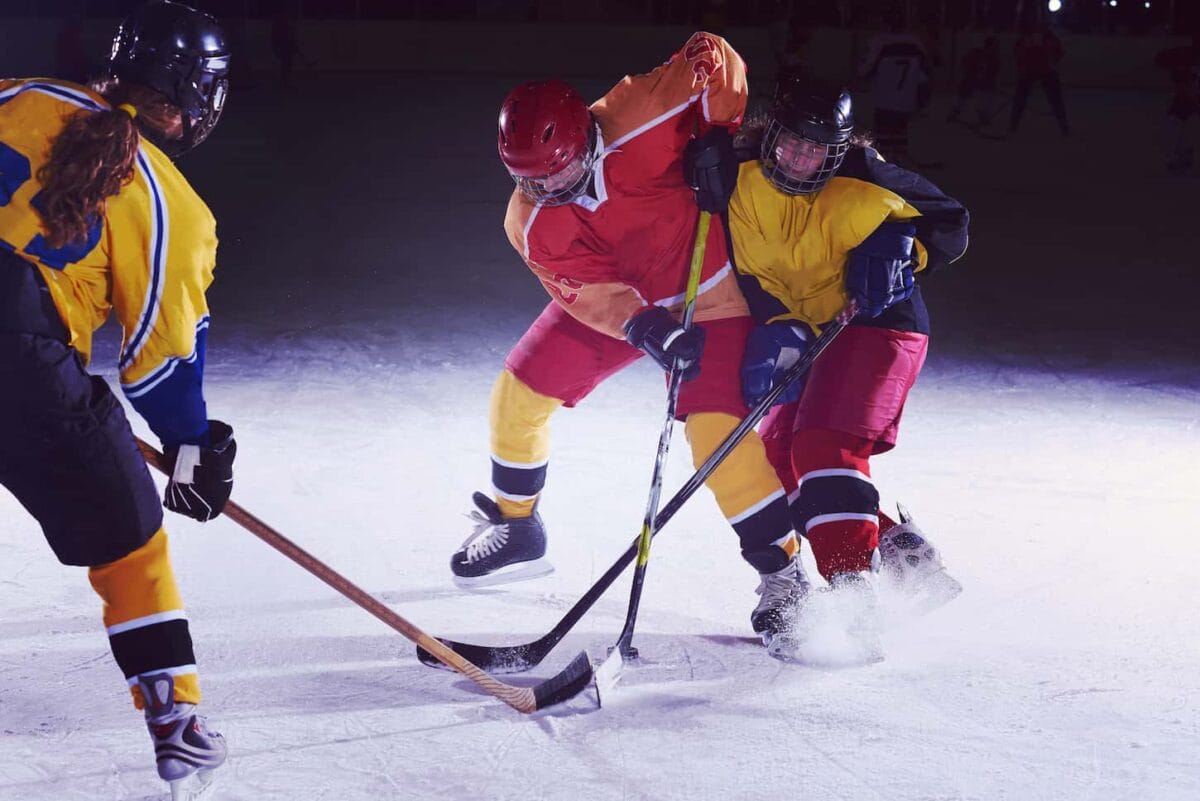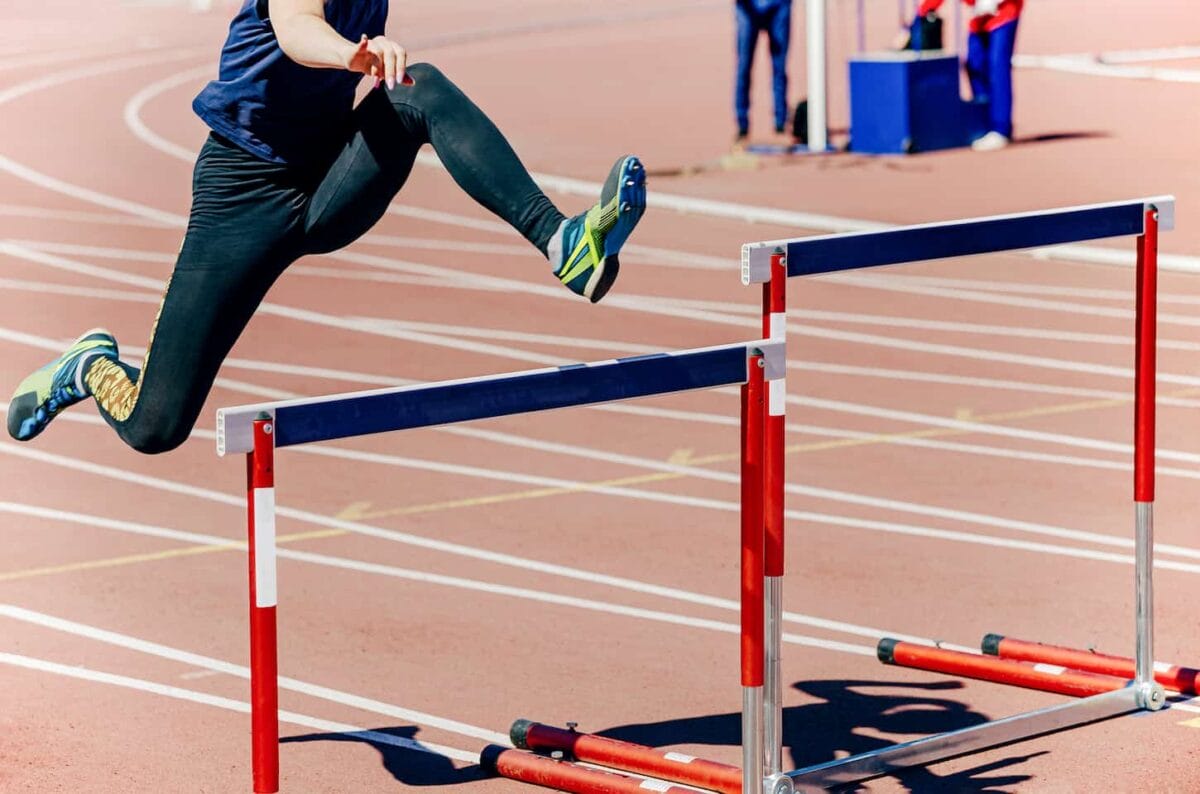Sports keep teenagers fit and are a fantastic way to improve their emotional well-being and teach them about self-discipline. Being part of a team gives teens a purpose and boosts their confidence and self-esteem.
The safest sports for teenagers include swimming, tennis, cross country, track and field, and soccer. These sports have low injury rates and provide an excellent physical workout.
Teenagers are still growing and developing, which means they’re more susceptible to injuries, so it’s essential to consider the risks when we choose a sport. If parents are keen to get their teens involved in sports but are concerned about potential injuries, they might wonder which ones are safest.

Understanding Risk Levels of Various Sports
Each sport has different risk levels – and even safe sports can be dangerous. High-impact, fast-paced contact games such as hockey or American football are high-risk sports, while low-impact, non-contact sports such as swimming and tennis are less risky.
Understanding the risks involved with each sport means a better chance of avoiding injuries. To determine how risky a sport is, we must consider several factors, such as the overall injury rate, the risk of concussion, and the severity of common injuries related to the sport.
Additional risks come from external factors such as the playing environment and the quality of coaching and supervision. When assessing risk levels, we must also account for the player’s age, fitness level, health, and body composition.
The Healthy Sport Index
The Healthy Sport Index is an online tool based 75% on research and 25% on expert opinion, which ranks ten of the safest sports for teens. Researchers and medical professionals from the Hospital for Special Surgery, Aspen Institute Sports, and the Society Programme created the index.
The Healthy Sport Index uses a holistic approach to rate the safety of sports. It accounts for physical risk factors such as injury rates but balances them with the social and emotional benefits of the sport.
The index suggests that even if a sport has some physical risks – if players are generally high achievers who don’t smoke or take drugs, the benefits may outweigh the dangers.
The index gives a separate list for boys and girls and offers a list of complimentary sports for teenagers to try alongside their primary sport.
The Five Safest Sports For Teens
According to the Healthy Sport Index, swimming, cross country, track and field, tennis, and soccer are some of the safest sports for teenage boys and girls. These sports have many physical, social, and emotional benefits and the lowest risk levels.
Let’s take a closer look at the top five safest sports for teens below:
Swimming
Swimming has the lowest injury rates. It’s low impact and doesn’t put pressure on muscles and joints. It provides an excellent cardiovascular workout, and each stroke works for different muscle groups.
The Healthy Sports Index rates swimming as the safest sport for girls and the 2nd safest for boys.
Accidents don’t often happen in the swimming pool, but there is a risk of drowning, so we must supervise teens at all times. The most common problems with swimming are muscular ones, such as the swimmer’s shoulder. Teens must use the correct swimming techniques to avoid injuries.
Cross-country
Cross-country is rated the safest sport for boys and 2nd safest for girls in the Healthy Sport Index. It provides a fantastic cardiovascular workout and helps teens build stamina and self-discipline. Teens who run cross-country are high achievers and less likely to smoke or abuse substances.
Cross-country running has one of the lowest concussion and catastrophic injury rates; when injuries happen, they generally aren’t severe. The most common injuries occur in the leg, ankle, knee, and foot, including sprains, strains, and shin splints.
To practice cross country safely, teens must wear well-fitting, shock-absorbing running shoes and socks – choosing the correct shoes is essential. They must also dress for the weather, learn safe routes, and always take a cell phone.
Tennis
Tennis is a mentally challenging sport with a focus on the upper body. It is a fantastic way for teens to improve hand-to-eye coordination and build self-discipline and stamina. The Healthy Sport Index ranks tennis as the 3rd safest sport for girls and the 5th safest for boys.
Tennis provides a fantastic cardiovascular workout and improves balance, endurance, flexibility, and agility. Tennis players are generally high achievers, and it’s an excellent sport for psychosocial development.
The injury rates in tennis are low, and injuries that occur don’t result in missing much practice time. The most common injuries are overuse ones, such as tennis elbow. To avoid tennis injuries, teens must learn the correct techniques and play complementary sports to avoid overuse.
Track and field
The Healthy Sport Index rates track and field as the 3rd safest sport for boys and the 7th safest for girls. Track and field sports are strenuous – they test different athletic abilities but do not result in many injuries. The most common injuries are to the hip, thigh, and upper leg.
The focus of track and field is on running, hurdles, jumping, and throwing, and it’s a fantastic way for teens to build speed, strength, and endurance.
Participants usually practice 2 or 3 times a week, so it’s excellent for improving social skills. Track and field players are also less likely to smoke and binge drink.
Soccer
Soccer has the highest injury rates on this list, but it is the best sport for psychosocial development. It ranks 4th safest sport for boys and 5th safest for girls on the Healthy Sport Index.
Playing soccer has many physical benefits – it builds stamina, balance, and leg strength and teaches teens to use initiative and set personal goals. It’s a fantastic sport for developing social, cognitive, and personal-development skills.
Soccer has a high concussion and injury rate but is one of the safest fast-paced contact sports compared to rugby, football, and ice hockey. Common injuries occur in the foot, thigh, upper leg, ankle, and sometimes the face, but most soccer injuries usually don’t result in missed practice time.
If your teenager is interested in playing multiple sports, parents should read this article first: How Many Sports Should a Teenager Be Playing? Here’s the Truth.

Why “Safe” Sports Aren’t Injury Free
All sports come with risks, even the safest ones – the difference is that the risks are much lower in some sports. With safe sports, teens are less likely to get injured, but there is still a chance that an accident can occur, especially if they do not follow the rules and guidelines.
I was on the swim team in high school. I also did track and field during middle school (junior high). Even though they are “safe” sports, I still managed a few injuries – proof that even “safe” sports aren’t 100% free from risk.
Factors Leading to Injuries in Youth Sports
Injuries in youth sports can occur if teens do not understand the rules and risks involved in the sport. They are also more at risk of injury if they do not have the correct coaching, form, supervision, or safety equipment.
Many sports injuries occur from overuse or improper form – when teens don’t know how to participate safely; go beyond their physical limits; or spend too much time practicing. Teens like to push their physical boundaries, but we must teach them to stop playing if they feel pain or fatigued.
Practicing several sports or seasonal ones is the best way to prevent overuse injuries.
Strategies for Reducing the Risk of Injury While Playing Sports
Strategies for reducing the risk of injury while playing sports should focus on preventing overuse injuries and ensuring teens are physically fit and healthy before the season starts with a pre-season examination.
They should start the season slowly and work up to intense exercises. Teams should consist of players of the same size, age, fitness level, and experience to reduce the chance of injury. Parents and coaches must have a first-aid strategy and learn about concussions.
You can find out more about concussions in our article here. Teens must see a doctor for a suspected concussion or if they have consistent pain during or after playing. Seek medical advice if persistent joint swelling, weak joints, or pain that does not subside after rest.

Tips for Safety in Sports for Teens
Even the safest sports come with risks, and to minimize the chances of injury, we must ensure teenagers are supervised at all times during play. Please provide them with a safe playing environment and safety equipment, and ensure they warm up properly and keep hydrated.
If parents want their teens to stay safe when they play sports, take a look at the four safety tips below.
Provide a Safe Playing Area and the Correct Safety Equipment
Teens must play sports in a safe area suitable for the sport. We must ensure courts and pitches are in good condition and surfaces are not slippery. Providing teens with the correct safety equipment is crucial to prevent injuries.
Each sport requires different safety equipment, so speak to the coach to determine what equipment a teen needs.
Here are some examples of safety equipment:
- Helmets – Helmets reduce the risk of head injuries by 75-85 percent and are crucial for sports such as baseball, hockey, football, lacrosse, softball, and cycling. Choose a helmet suitable for the sport and which meets safety standards.
- The helmet must be the correct size – so it doesn’t slip or cover the eyes, and we must replace helmets after an impact.
- Eye Protection – Goggles and face guards reduce the chance of eye injury by up to 90% and are common in lacrosse, football, ice hockey, and baseball. If a teen wears glasses, they need prescription shields because they mustn’t wear glasses during sports.
- Mouth Guards – These are essential for contact sports such as martial arts, hockey, lacrosse, football, and boxing because they reduce the chance of dental damage.
- Mouth guards can be fitted at the dentist or purchase a generic version from a sports store. Teens shouldn’t wear a mouthguard with a retainer and must clean it thoroughly between uses.
- Joint Guards, Body Pads, and Protective Cups are crucial for contact sports such as skateboarding, cycling, hockey, and soccer. Joint guards protect the knees, wrists, and elbows against trauma and breaks.
- Body pads such as the shin, chest, shoulder, hip, and thigh protect the corresponding areas from injury. Protective cups minimize the chance of groin injury in boys.
- Footwear – Teens must choose footwear suitable for the sport, such as cleats for soccer or running shoes for cross country. Footwear must be the right size and comfortable fit to provide stability and prevent tripping, slipping, and falling.
Warm Up and Cool Down Properly
Teens must warm up and cool down properly before and after exercise to reduce the chance of injury. If they do not warm up and loosen their muscles before playing, they are more likely to suffer from sprains and muscle injuries.
Teens should warm up for at least 10 minutes before playing sports. They should start with jumping jacks, light jogging, shuffling, and kicks to increase heart rate and body temperature. When the muscles are warm, they should do dynamic stretches, such as lunges and arm circles.
After exercise, teens should do static stretches to wind down. Static stretching is when they hold the pose rather than move into it. Static stretches include standing hamstring, quad, chest, and groin stretches. They should hold the postures for 30 seconds.
Keep Hydrated
It is easy for teens to become dehydrated when they exercise, and they must drink plenty of water during and after sports, especially in hot weather. Dehydration can lead to illness and make players more susceptible to injury.
Dehydration occurs when teens lose more fluids than they consume. They will sweat more during high-activity sports, and If they do intensive exercise, more than two hours a day, they will also need electrolytes.
Signs of dehydration include dehydration, dizziness, dry mouth, and nausea. If a teen shows signs of dehydration, sit them in the shade and get them to drink lots of water.
Know the Rules
If teens do not know the rules and risks involved with a sport – they are more likely to be injured. Each sport has different risks and safety guidelines, and teens must know the ones for their sport.
The rules are there for safety and to prevent injuries. In soccer, players must know to stop when the whistle blows, for example. Teens must learn the correct tackling and playing techniques and practice good sportsmanship.
Teens must also know the limits of their position and where they should be on the field.
Best Products for Sport Safety
Having the right safety gear is vital to playing sports safely, no matter the sport. Having the right gear for the sport will depend, so here are links to some articles we’ve written on gear.
- 5 Must-Have Archery Safety Gear for Teens!
- Can Soccer Goalies Wear Sunglasses? Guidelines For Protective Gear
- Futsal vs. Turf Shoes: What’s the Difference?
- Volleyball Equipment: Necessities, Costs, and Alternatives
We’re always working to provide more articles, so if you don’t see what you want in the list above, feel free to search this site using the menu or the search bar at the top of the page.
And if we still don’t have what you want? Use our contact page to let us know! That way, we can prioritize publishing an article to help you get the necessary information.

Key Takeaways and Next Steps
All sports come with risks, but some are more dangerous than others. Parents should encourage teens to play safe sports such as swimming, cross country, tennis, track, and field, or soccer to reduce the chance of injury.
To further reduce the chance of injury, ensure teens understand the rules and risks involved in the sport, provide them with a safe playing area and safety equipment, and supervise them at all times. Teens must also ensure they warm up before playing and stay hydrated, especially in hot weather.
If a teen is stressed out, several sports are perfect for relieving stress in this informative article: 11 of the Best Stress-Relieving Sports to Try Out.
Resources
Learning from your own experiences is important, but learning from others is also smart. These are the sources used in this article and our research to be more informed as a family of sports nuts wannabes.
- 10 Tips for Preventing Sports Injuries in Kids and Teens. (2022, April 10). Johns Hopkins Medicine. https://www.hopkinsmedicine.org/health/conditions-and-diseases/sports-injuries/10-tips-for-preventing-sports-injuries-in-kids-and-teens
- Bahr, R., & Holme, I. (2003). Risk factors for sports injuries — a methodological approach. British Journal of Sports Medicine, 37(5), 384–392. https://doi.org/10.1136/bjsm.37.5.384
- Enjuris. (2017, September 25). What are the Safest Sports for Children? https://www.enjuris.com/blog/resources/safest-sports/
- Healthy Sport Index, Aspen Institute Sports and Society Program. (2019, May 6). Safety Report for Sports | Healthy Sport Index | Healthy Sport Index | Aspen Institute Sports and Society Program. https://healthysportindex.com/report/safety-analysis-report/
- Kewish, B. (2022, March 2). Understanding Sports Injury Risk – guest blog by Lachlan Porter. Hills Physiotherapy. https://hillsphysiotherapy.com.au/injury-risk/
- Sports Safety for Children. (2021, August 8). Johns Hopkins Medicine. https://www.hopkinsmedicine.org/health/wellness-and-prevention/sports-safety-for-children
- Teen Injury Prevention & Sports Safety Tips | HSS. (n.d.). Hospital for Special Surgery. https://www.hss.edu/pediatrics-tips-help-teens-train-compete-safely-sports.asp
